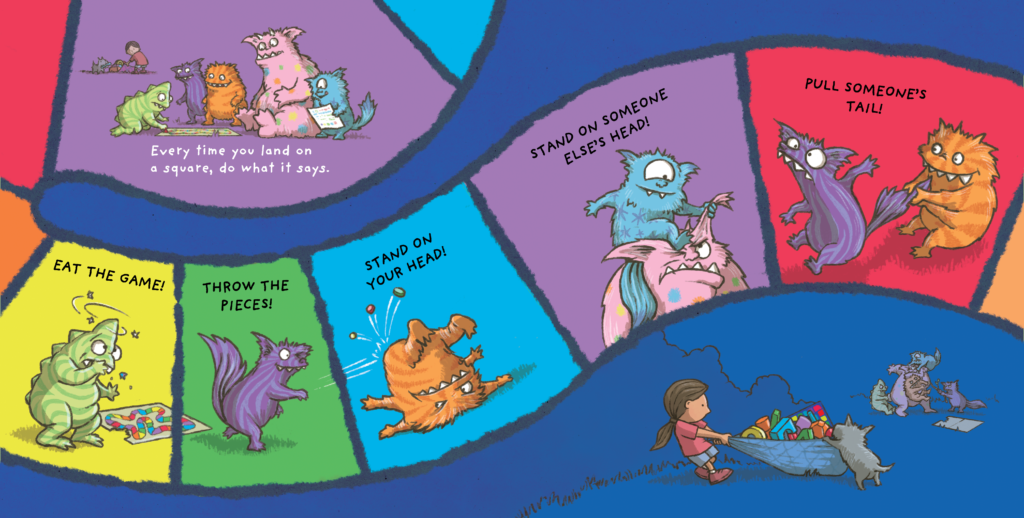Kirkus
Board games, much like playtimes, take two or more players to make everything go right. Schoolkids need a helping hand as they move from solo to social play—especially in a screen-oriented world—and McElligott here guides them along. Illustrated in a game board-style layout and written in the imperative style of game instructions, this clever book externalizes kids’ worst playtime impulses in the form of literal monsters. Readers first encounter a small child laden with a big, multicolored game box. When the family’s gray terrier wanders out of the room, the kid lets a pink, furred monster in through the window to serve as a substitute playmate. Things begin well enough, but, as a crowd of monsters accumulates and overwhelms the protagonist, the loyal pup returns to scare them off. Unfortunately, the furry fiends abscond with the game board, then refuse to give it back. Undaunted, the enterprising kid handcrafts a decoy game that distracts the thieving horde with explicitly naughty directives—throwing pieces, munching the board, and so on—enabling the retrieval of the board. Once the monsters realize good fun is contingent on good sportsmanship, they apologize and rejoin the game. By the amicable ending, readers have discovered the basics of fair play: abiding by the rules, waiting your turn, respecting your competitors, winning (and losing!) gracefully, and, per the titular mandate, abstaining from conspicuous consumption. This book requires two or more readers—the more participants, the merrier. (Picture book. 5-8)
Booklist
Any child who has broken the rules of a board game, thrown the pieces, or suddenly quit the game can identify with and delight in this Jumanji-lite story of a game that turns chaotic. As a little girl and her dog open a board game and start reading the rules—which make up the entirety of the book’s text—a fuzzy, pink-polka-dotted monster peers through the window. Soon, it joins the game and begins tossing pieces and eating the game board itself, and more of its monster friends join, merrily creating chaos. There are four games here: the original; the second, where the cute monsters carry off the game pieces; the third, where the girl makes up her own game with insane rules for the monsters; and the fourth, in which she and the monsters play the original game properly. The book itself is designed like a board game, with brightly colored panels mimicking game spaces. Ultimately, this is a cleverly zany take on how difficult forming friendships can be. (April 1, 2020)

Bulletin
“This game is for two or more players. It is easy to learn. . . . It’s also a great way to make new friends.” So proclaim the instructions of a boardgame that our young protagonist opens, and she then invites monsters into her home to play. However, the monsters blatantly ignore the continued instructions (“Do not throw the pieces. Do not eat the game”) and generally cause chaos, eventually stealing the game and running off. The girl creates her own game for the monsters to play that mimics the game they ruined (“Every time you land on a square, do what it says. EAT THE GAME! THROW THE PIECES!”) and steals the original game back while they’re distracted; the monsters then return to play the game fairly and even help clean up. McElligott cleverly formats this readaloud with each panel shaped like squares that weave in and out of pages against alternating color backgrounds, replicating a game board. The contrast between the cheery instructions and the illustrations is often comical (“And always remember to have fun!” the instructions exhort as the girl and her dog storm angrily away). Though the monsters are rowdy, they look ready to cuddle, with soft fur in striped and polka dot patterns, and viewers are sure to wish they could stampede around with their own monster friends. (June 2020)
